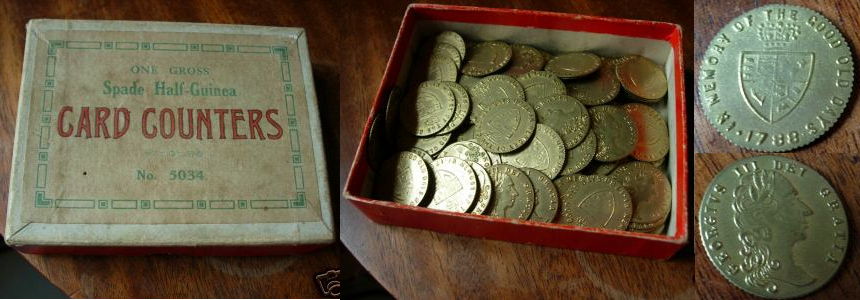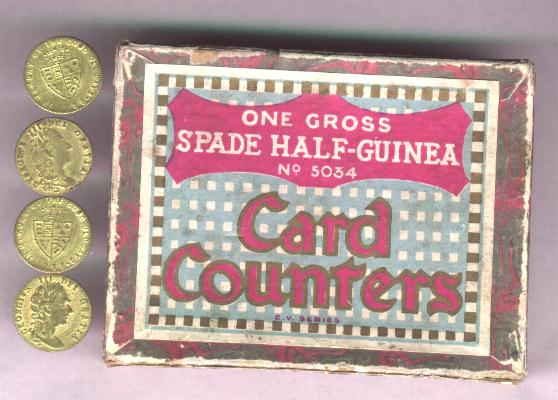Georgius III Dei Gratia 1797

26mm, brass
About this token:
- July 2006 - following information was from an eBay auction:
IMITATION SPADE GUINEAS
There is an extensive series of Advertising and Standard Imitation Spade Guineas,
issued in brass and not gold, mostly in the 1800’s during the reign of Queen
Victoria although to avoid the Counterfeit Laws they have the bust of King
George III, mainly, and the reverse is usually the spade shield, – hence the
name “spade guinea”. Many are also dated in the 1700’s and not in the 1800’s.
Their purpose was as gaming gambling counters, to look like sovereigns and
half sovereigns, also to show off the expertise of the engravers and manufacturers
many of whom were named on the piece – mainly from Birmingham, UK – and as
advertising tokens for many types of business, as “give away’s” or promotional
items. Many were pierced at manufacture for suspension purposes and it is
perfectly acceptable to collect coins in that condition. There are over 1,000
different types to collect and this is a growing sector of Numismatic interest.
Whilst some pieces – such as the “In Memory of the good old days” are extremely
common, some of the advertising pieces are excessively rare and command prices
of well over £100. The work of reference for the whole series is “A Thousand
Guineas” by W Bryce Neilson, published in 2003 and covering 70 pages. Cost
£16. [The book "A Thousand Guineas" is available from Galata
for about $37 US including shipping (price subject to change)]
- April 2006 - Another box of these tokens on eBay: 133 george 111 gaming
token in original box dated 1788. Sold for $41 plus shipping (from England)

- Dec. 2004 - I just spotted an interesting auction on eBay: "JETONS.
144 Spade Half Guineas in Original Box." No information about age, but
had the following picture:

- An article about these tokens appeared in "Coin News", Oct. 1983, p. 46-7.
- Very often in the old English and French 18th century there was a shortage
of hard currecy. People would mint there own coinage. Fake or real looking
was purportatdly in circulation of up to 80% of the copper during that time
period. As a result these midnite minters would use the equipment to provide
gaming tokens for the wealthy to use in their gambling areas. Either at home
or in casinos. These jeton like pieces are pretty common and you can pick
them up here and there for anywhere between 2 and 20 dollars each.
- As you rightly say the imatation spade guineas dated 1797 (and many other
dates) were used as gaming counters. They are fairly common and are to be
found with various ledgends. They were produced prolifically during the Victorian
and Edwardian periods and used more by families in homes for playing cards
than in gaming houses. I recently bought a box of junk and in it was small
box containing about 100 of the spade guinea type and 30 smaller silver coloured
ones, which I have never seen before.
- An imitation Guinea (imitation of a George III Guinea). There are many different
type of these and sizes do vary. Many piece though have the ". Good old days"
legend. These were used as gaming counters a LONG time ago.
- I have seen this before. All I can say for sure is it is not from 1797.
It is not listed in Dalton & Hamer, the definitive reference for British tokens
of this period.
Know anything about this token? Please send me a note: pineconeforge(at)gmail.com
Return to foreign
mystery tokens.

